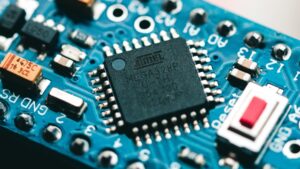This website uses cookies so that we can provide you with the best user experience possible. Cookie information is stored in your browser and performs functions such as recognising you when you return to our website and helping our team to understand which sections of the website you find most interesting and useful.
The Future of American Manufacturing: Bringing Semiconductors and Chips Home
Recent global events and ongoing challenges from COVID-19 have created persistent global supply disruptions—proving the need for a stronger, more resilient domestic supply chain.
A variety of U.S. businesses and corporations are starting to consider the repatriation of overseas manufacturing jobs to protect themselves from the risks of relying on manufacturers across the ocean, including:
- Delayed shipments
- Increased freight and materials costs
- Product shortages and depleted inventories
- Longer lead times
- Labor issues
- Quality control issues
- Theft of intellectual property

These risk factors not only hinder the internal manufacturing services, but also pass down unwanted delays and costs to the customers and end users. “We’ve definitely seen a pretty big increase in lead times for certain metals, specifically copper,” said Cody Bolstad, Materials Coordinator/Buyer for Fotofab. “Normally, we could get copper in two to three weeks, but now it can take up to six months.”
Relaunching American-Made Semiconductor and Chip Components
One strategy to strengthen the U.S. supply chain, and mitigate risk, involves focusing our manufacturing efforts on semiconductor and chip production rather than only research and development.
Semiconductors are at the heart of all our communication networks—They power our advanced technologies and are closely linked to military, space, and aeronautical communications development, which support a quarter million U.S. jobs.
According to Intel, the U.S. share of global semiconductor manufacturing has declined from 37% in 1990 to 12% today, “undermining U.S. technology leadership with significant economic and national security implications.”
Those who invest in semiconductor production are given a competitive advantage in key technologies such as artificial intelligence and high-speed communications.
The Benefits of Reshoring Semiconductor and Chip Production
Companies that outsource their production needs to manufacturers overseas do so because of lower labor, environmental, and materials costs. However, recent disruptions in the supply chain virtually eliminate any cost advantages, and companies are being exposed to “multiple vulnerabilities including inconsistent product quality and costly port slowdowns.“
By reshoring the manufacturing processes of semiconductors and chips, companies can increase their agility, shorten their lead times, reduce their inventories, meet fluctuating delivery requirements, and respond quickly to their customer demands.
“What is better for a buyer or engineer facing disruptions in the supply chain than a supplier that can provide alternative options; but also take it one step further and provide a complete turnkey solution that can save them costs as well as time,” asks Anthony Giampapa, Director of Sales at Fotofab.
Reshoring also provides opportunities for companies to be closer to their suppliers and facilitate more collaborative working relationships that are better for protecting their intellectual property and expanding their overall manufacturing ecosystem, especially with higher-volume projects.
Other advantages bringing semiconductor manufacturing home include:
- Increased employment opportunities
- Reduced trade deficit and stronger economic stability
- Expanded innovation and competitive advantages
- Improved quality control and production processes
- Reduced risks and time zone differences
- Accelerated time-to-market
- Streamlined distribution of goods
- Strengthened national security
How Photochemical Etching Fits the Semiconductor Reshoring Initiative
As more companies bring their production back to America, one technique to consider for the complex semiconductor design process is photochemical etching. Chemical etching is suitable for various metals, including stainless steel, copper, gold, and silver.
Intricate, complex designs that are burr- and stress-free can be manufactured within as little as one week turnaround times, generally at lower costs compared to CNC machining and laser etching. The process also adapts effortlessly from one-off prototypes to high-volume production runs.

